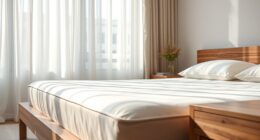If your room feels dry, a humidifier can add moisture to ease breathing, soothe dry skin, and improve sleep comfort. On the other hand, if your space is damp, musty, or moldy, a dehumidifier helps remove excess moisture, making the air clearer and more breathable. Choosing the right device depends on your environment’s humidity levels. Keep exploring to learn how to optimize your sleep environment with the best device for you.
Key Takeaways
- Humidifiers improve sleep by adding moisture to dry air, relieving dry skin, nasal irritation, and sore throats.
- Dehumidifiers enhance sleep by reducing excess moisture, preventing mold, musty odors, and breathing difficulties.
- Proper humidity levels (40-60%) maintained by either device support optimal sleep comfort and airflow.
- Use humidifiers in dry environments and dehumidifiers in damp, mold-prone spaces for better sleep quality.
- Selecting devices based on room size, noise level, and maintenance helps ensure continuous, undisturbed sleep.
How Humidifiers and Dehumidifiers Affect Air Quality
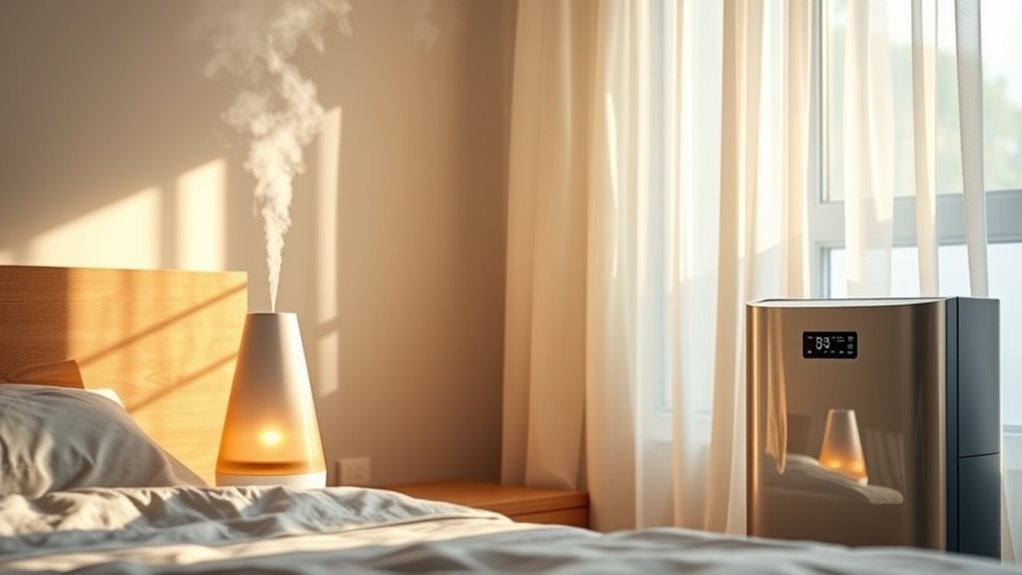
Humidifiers and dehumidifiers play a crucial role in shaping the air quality in your home. They help improve air purification by reducing airborne pollutants, allergens, and bacteria, making the environment healthier. A humidifier adds moisture, which can decrease dust and static electricity, while a dehumidifier removes excess moisture that fosters mold and mildew growth. Both devices also impact energy efficiency; modern models are designed to operate effectively without consuming excessive power. Proper use ensures you maintain ideal humidity levels, reducing indoor air pollutants and creating a cleaner, more comfortable space. Additionally, understanding the contrast ratio can help you select devices with better performance in varying conditions. By choosing the right device and maintaining it well, you enhance air quality and make your home healthier and more energy-efficient.
The Impact of Humidity Levels on Sleep Comfort
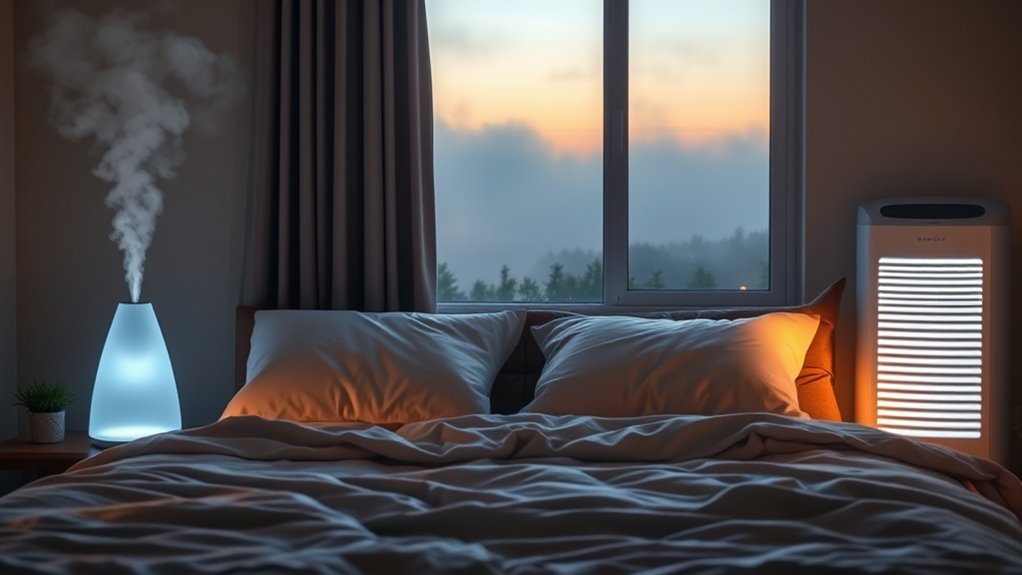
Maintaining the right humidity levels in your bedroom can considerably influence your sleep quality. Proper humidity supports ideal air circulation and temperature regulation, making it easier to fall asleep and stay asleep. When humidity is too low, your skin and airways dry out, causing discomfort. Conversely, high humidity can make the room feel stuffy, disrupting your rest. Balancing humidity enhances airflow, reducing stuffiness and promoting a comfortable environment. Consider this table:
| Humidity Level | Effect on Sleep |
|---|---|
| Low (<30%) | Dry skin, nasal irritation |
| Ideal (40-60%) | Comfortable, better airflow |
| High (>60%) | Stuffy, difficulty breathing |
Keeping humidity within the perfect range ensures your sleep environment remains comfortable, supporting effective air circulation and temperature regulation for restful nights.
When to Use a Humidifier for Better Rest
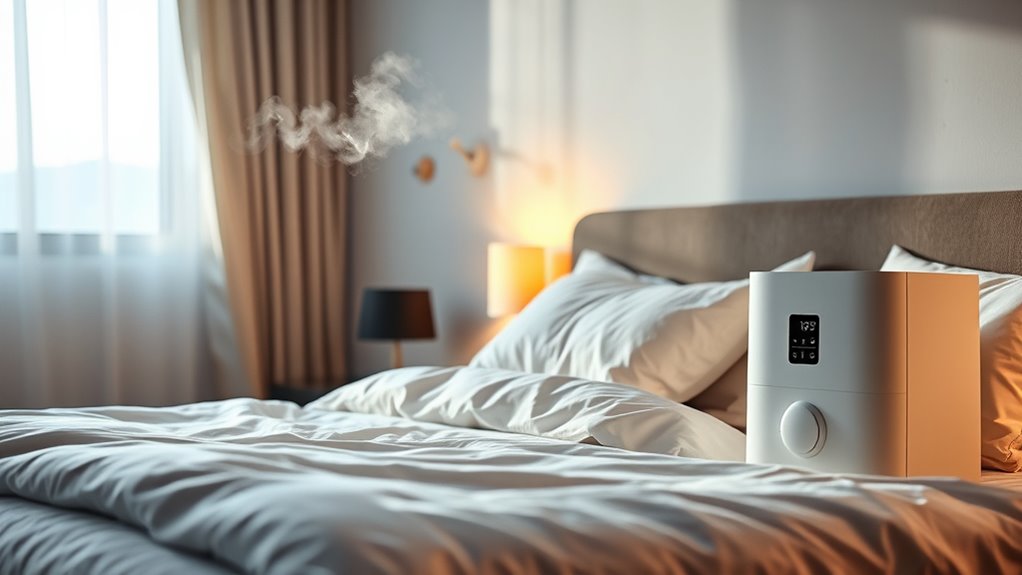
If you notice your skin feels dry, your nasal passages are irritated, or your throat is sore, it’s a clear sign that adding moisture to your environment could help improve your sleep. Use a humidifier when your sleep environment is too dry, especially during winter or in heated spaces. Proper humidity levels enhance breathing comfort, preventing congestion and dry throat that can disrupt rest. A humidifier can also reduce static and soothe irritated skin, making it easier to fall asleep and stay asleep. Keep humidity between 40-60% for ideal comfort. When your environment lacks moisture, a humidifier helps create a more comfortable sleeping space, supporting better rest and healthier breathing throughout the night. Maintaining optimal humidity levels is essential for overall sleep quality and comfort.
Situations Where a Dehumidifier Can Improve Sleep Quality
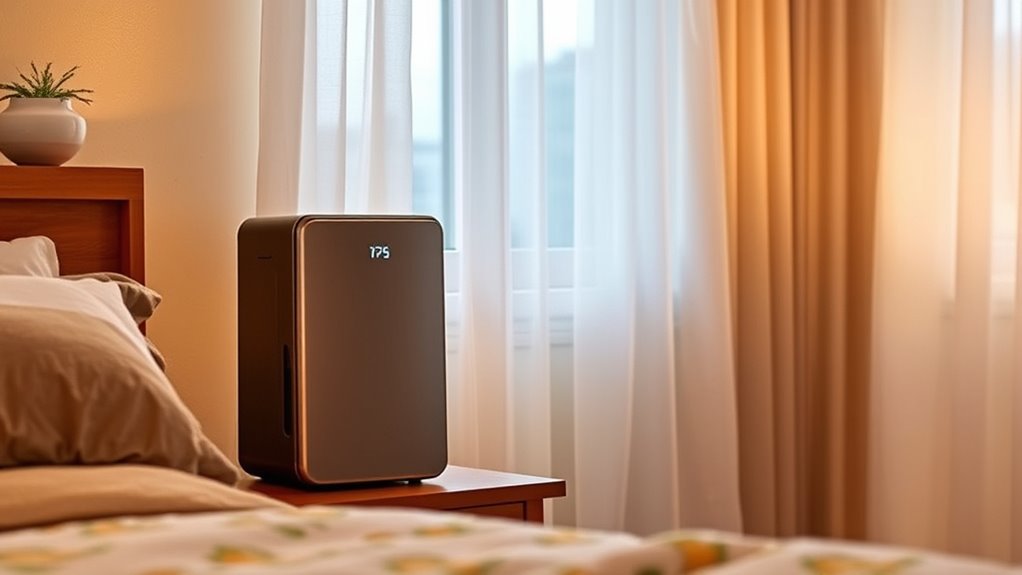
If your bedroom feels damp or musty, a dehumidifier can help reduce mold growth that might disrupt your sleep. It also controls allergens and dust, making the air cleaner and easier to breathe. By maintaining ideal humidity levels, you can enjoy more restful, uninterrupted sleep. Additionally, using a dehumidifier can help prevent the proliferation of mold and bacteria, which are common concerns in areas with high humidity.
Reduces Mold Growth
Because mold thrives in damp environments, using a dehumidifier can substantially reduce mold growth in your bedroom, especially during humid seasons. By lowering moisture levels, you create an inhospitable environment for mold, supporting mold prevention and improving air purification. This not only helps prevent mold spores from spreading but also enhances your sleep quality by reducing musty odors and allergen exposure. The table below illustrates how dehumidifiers target moisture and mold:
| Benefit | How It Works | Impact on Sleep |
|---|---|---|
| Reduces mold growth | Lowers humidity, inhibits mold | Less mold-related allergies |
| Enhances air quality | Removes excess moisture | Breathing becomes easier |
| Supports mold prevention | Maintains ideal humidity | Less mold spore inhalation |
| Promotes healthier environment | Keeps mold at bay | Better sleep comfort |
Controls Allergens and Dust
Have you ever noticed waking up with sneezing, congestion, or itchy eyes even after a full night’s sleep? If so, a dehumidifier might help. High humidity levels can increase airborne allergens and dust mites, worsening allergy symptoms. By reducing indoor humidity, a dehumidifier helps control airborne allergens, making the air cleaner and easier to breathe. It also targets dust mite control, since dust mites thrive in humid environments. When humidity stays below 50%, it becomes less hospitable for these allergens, decreasing their presence in your home. This can lead to fewer allergy symptoms during the night and a more restful sleep. Using a dehumidifier in the right conditions creates a healthier sleeping environment, especially if allergies or dust sensitivities disturb your rest. Additionally, understanding production quantity variance can help manufacturers optimize their airflow and humidity controls to maintain ideal indoor conditions.
Signs Your Environment Needs Humidification or Dehumidification
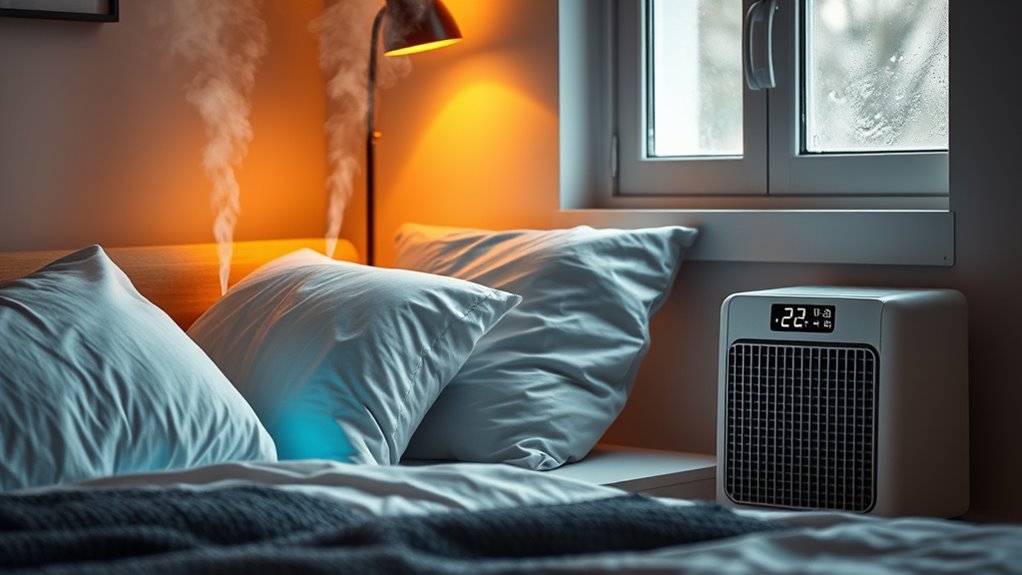
Your environment often gives clear signals when it needs either more humidity or less. If you notice dry skin, chapped lips, or frequent static, your air quality may be too dry, impacting your sleep comfort. Conversely, persistent mold, musty odors, or condensation on windows suggest excessive moisture, which can lead to poor air quality and disrupted sleep. Pay attention to your breathing—if you experience congestion or dry throat, it might indicate a need for humidification. On the other hand, if you’re waking up feeling sweaty or notice damp spots around your room, dehumidification could improve your environment. Recognizing these signs helps you adjust your space, ensuring ideal air quality and better sleep conditions. Additionally, understanding the importance of sleep quality can motivate you to maintain optimal humidity levels for restorative rest.
Choosing the Right Device for Your Bedroom
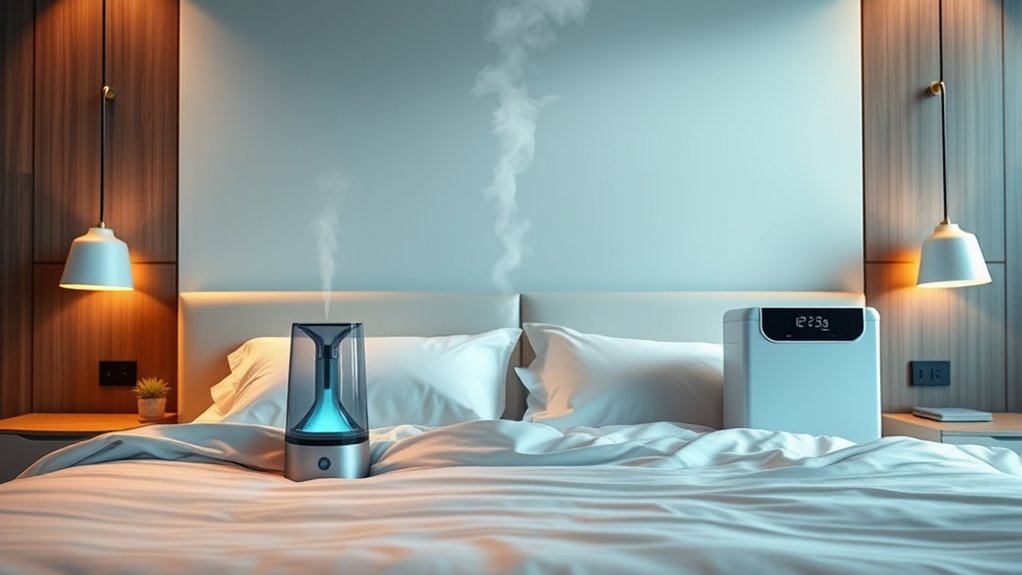
When choosing a device for your bedroom, you need to consider the room size to ensure it can effectively regulate humidity. Noise levels also matter, especially if you’re sensitive to sound while sleeping. Finally, look for a model that’s easy to maintain so you can keep it running smoothly without hassle. Additionally, understanding market research can help you select a device that aligns with current consumer preferences and proven features.
Room Size Compatibility
Choosing the right device size for your bedroom is essential to guarantee effective humidity control. A unit that’s too small won’t adequately manage the room’s moisture levels, while an oversized one can waste energy and create an uncomfortable environment. To optimize energy efficiency, select a device specifically rated for your room’s size. For small bedrooms, compact humidifiers or dehumidifiers work best, offering discreet operation and minimal energy use. Larger spaces require more powerful models to maintain consistent humidity levels. Additionally, consider the aesthetic appeal of the device; sleek designs blend better with your decor and won’t detract from your room’s ambiance. Matching the device size with your room size ensures efficient operation, enhances comfort, and helps you avoid unnecessary energy costs. Proper device sizing is crucial for maintaining optimal humidity levels and ensuring your sleep environment remains comfortable and healthy.
Noise Level Considerations
Since noise can disrupt your sleep or daily activities, it’s important to regard the sound levels of humidifiers and dehumidifiers before buying. A device that emits loud or constant noise can cause sleep disruption, leaving you tired and irritable. Look for models that produce white noise, which can actually help mask other sounds and promote relaxation. Additionally, choosing a device with appropriate Glycolic Acid benefits can contribute to overall comfort and skin health during rest. Consider these factors:
- Is the device labeled as “quiet” or “sleep-friendly”?
- Does it operate silently during nighttime use?
- Will the noise level cause sleep disruption or wake you up?
- Can you adjust the sound to your comfort?
Choosing a quieter device ensures you rest peacefully without unnecessary disturbances, allowing you to breathe better and wake refreshed.
Ease of Maintenance
Selecting a humidifier or dehumidifier for your bedroom means considering how easy it is to keep the device clean and maintained. Both require regular attention, but their maintenance tasks differ. Humidifiers often need filter replacement and cleaning every few weeks to prevent mold and bacteria growth. Dehumidifiers typically require cleaning of the water collection bucket and filter every month. Ensuring proper hygiene practices during maintenance can help prevent health issues. Both devices benefit from regular checks for mold and dust buildup to maintain optimal performance.
| Device Type | Filter Replacement | Cleaning Frequency |
|---|---|---|
| Humidifier | Every 2-4 weeks | Every 1-2 weeks |
| Dehumidifier | Monthly | Monthly |
| Both | Check for mold | As needed |
| Airflow vents | Clean every 1-2 weeks | Clean every 1-2 weeks |
| Water tank | Clean weekly | Clean weekly |
Choosing a device with straightforward maintenance ensures consistent performance and better sleep quality.
Tips for Maintaining Optimal Humidity for Rest
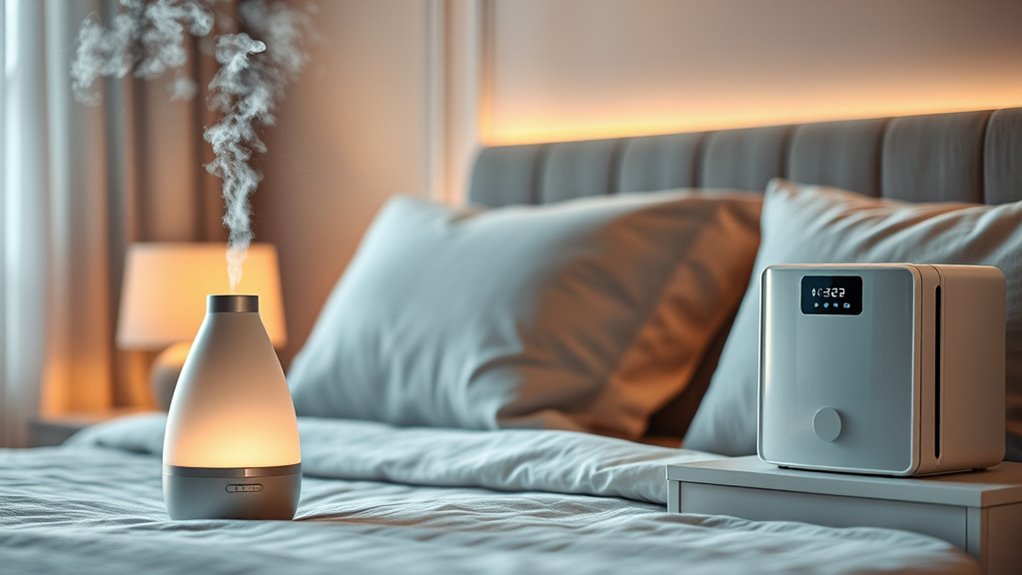
Maintaining the right humidity levels in your bedroom can considerably improve your sleep quality. To achieve this, focus on effective humidity monitoring to keep levels between 40-60%. Here are four essential tips:
- Regularly check humidity levels with a reliable hygrometer to prevent discomfort.
- Use air purification devices alongside humidifiers or dehumidifiers to remove allergens and pollutants.
- Clean your devices frequently to avoid mold and bacteria buildup.
- Adjust your equipment seasonally, increasing humidity in winter and reducing it during humid summer months.
- Consider the Kia Tuning options available to optimize your vehicle’s climate control system for better air quality and comfort inside the cabin.
Frequently Asked Questions
Can Using Both a Humidifier and Dehumidifier Improve Sleep Simultaneously?
Using both a humidifier and dehumidifier can create a dual device synergy that improves sleep by maintaining the ideal humidity balance. You’ll find your environment more comfortable, reducing issues like dryness or excess moisture that disrupt rest. This approach helps you breathe easier and sleep more soundly. Just ensure you set each device correctly to avoid overcorrecting, and you’ll enjoy a healthier, more comfortable sleeping environment.
Are There Health Risks Associated With Improper Humidity Levels During Sleep?
You should be aware that improper humidity levels can pose health risks during sleep, like respiratory issues or allergies. A humidity imbalance, whether too high or low, can cause discomfort and increase the risk of infections. To avoid these health risks, monitor your home’s humidity and keep it between 30-50%. Using devices properly helps maintain balanced humidity and supports healthier, more restful sleep.
How Loud Are Typical Humidifiers and Dehumidifiers in a Bedroom Setting?
You’ll find that typical humidifiers and dehumidifiers have moderate noise levels, usually ranging from whisper-soft to a gentle hum. Many models are designed for bedroom comfort, so they operate quietly enough to not disturb your sleep. If noise is a concern, look for units labeled as “quiet” or “sleep mode.” Overall, choosing a device with low noise levels helps maintain a peaceful environment, ensuring restful sleep.
Do Smart Devices Help Automatically Regulate Humidity for Better Sleep?
Imagine drifting into sleep as your room’s humidity stays perfect, thanks to smart sensors that monitor moisture levels. These devices make automated adjustments, turning humidifiers or dehumidifiers on or off seamlessly. You won’t wake up feeling stuffy or dry, because smart devices maintain an ideal environment, ensuring your sleep is uninterrupted and comfortable. With this technology, you get peace of mind knowing your room adapts effortlessly to keep your sleep ideal.
What Are the Energy Consumption Differences Between Humidifiers and Dehumidifiers?
When comparing energy efficiency and power consumption, humidifiers typically use less energy than dehumidifiers. Humidifiers run continuously to add moisture, but they tend to have lower wattage. Dehumidifiers often consume more power, especially large or high-capacity models, because they work harder to remove moisture. If you’re mindful of energy, choosing a smaller or inverter model for either device can help reduce power consumption and save on energy bills.
Conclusion
Ultimately, finding the perfect balance between humidifiers and dehumidifiers can transform your sleep into a sanctuary of serenity. Ignoring your environment’s needs can turn your bedroom into a battleground of discomfort, robbing you of restful nights. By paying close attention to humidity levels and choosing the right device, you hold the power to create a sleep haven so perfect, it’s like having a personal oasis right in your bed. Your ideal sleep environment is within your grasp—seize it.







